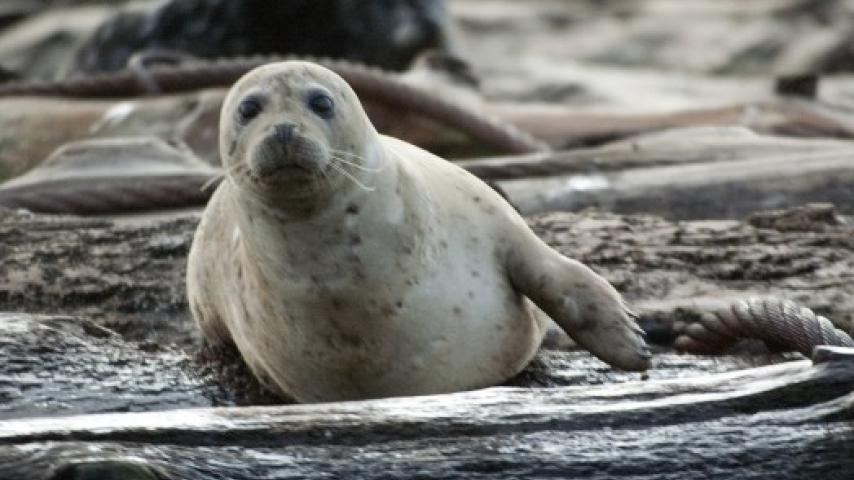Harbor Seal (Phoca vitulina)
Harbor Seals are the most commonly seen marine mammal in Puget Sound. They float at the surface with only the upper part of their head visible, showing the big brown eyes, nostrils flaring to take a breath, and sensitive “whiskers” (vibrissae) on either side of their snout.

KINGDOM Animalia - PHYLUM Chordata - CLASS Mammalia - ORDER Carnivora - FAMILY Phocidae
External ears (pinnae) are conspicuous lacking in this family, often called “earless seals.” This distinguishes them from the fur seals and sea lions that have obvious, if small, external ears.
As you approach, the seal will either dive or will orient its body vertically and rise slightly higher in the water, the better to see you. With closer approach, it disappears below the surface. Harbor Seals and their relatives have highly modified hind legs, basically a pair of webbed fins that can be sculled back and forth to drive the seal through the water at surprising speeds. Perhaps not too surprising, as they have to be fast to chase down fish, their primary prey.
Seals are well adapted to live in cold temperate waters, as their skin includes an insulating layer of dense blubber; fat does keep you warm. Their senses for detecting each other, potential prey and predators, are well honed, with big eyes that see well underwater and an acute sense of smell that serves them when out of the water (olfaction does no good underwater when it has to be accomplished through the nostrils!).
Although they belong to a separate suborder (Pinnipedia) from their terrestrial relatives, seals are carnivores, members of the same order as dogs and cats; bears are thought to be their closest relatives. A look at their skulls leaves no doubt of this, but the dentition has been modified for fish-eating. The canines are not as large as in most terrestrial carnivores, and the molars and premolars are relatively large, sharply pointed, and more uniform, well suited for holding onto slippery fish. A wide variety of fish species is included in their diet, including both solitary bottom fish such as sculpins and midwater schooling species such as herrings.
Seals stay in the water to feed and move about but haul out on land to rest, typically at low tide, and to have their young. Females mature in 3-5 years and usually have a single pup each year after that. One of the advantages of a good sense of smell is that the female and pup imprint on each other’s odor, just another way they can keep track of one another. The pup is nursed for up to six weeks but stays with its mother for some time thereafter.
Although most of a Harbor Seal’s life is spent near the surface, pinnipeds are capable of diving quite deeply. Harbor Seals are known to dive to about 500 meters and can probably hold their breath for 10 minutes or more. At high pressures, flexible ribs allow their lungs to collapse, and dense tissue in the middle ear protects that sensitive organ. When going deep, heart rate and oxygen consumption are reduced, blood is shunted to essential organs and tissues, and myoglobin in the muscles is the source of much of the oxygen used in respiration.


